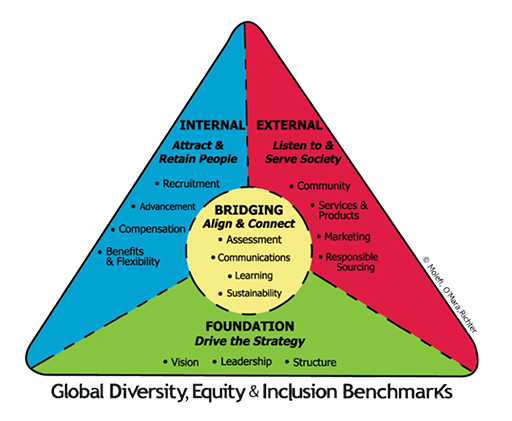2.3 Benchmarking
Another way to measure progress is to use existing benchmarks.
Global diversity equity and inclusion benchmarks (GDEIB)
The GDEIB aims to ‘help organisations determine strategy and measure progress in managing diversity and fostering inclusion’. (D&I Leaders, no date). It is a free resource that can be downloaded after agreeing to the terms of use and providing your contact details in an online form.
The GDEIB model consists of 15 categories organised into four groups – Foundation, Internal, External and Bridging – represented by this diagram:
Each category is divided into five levels, ranging from ‘Level 1 Inactive’ to ‘Level 5 Best Practice’.
Users variously describe the tool as ‘a practical guide for leaders across a variety of business functions’; ‘an invaluable contribution to our playbook as we work to further integrate D&I into our efforts’; ‘a systemic and structural approach to D&I, paving the way for a truly transformative journey’. (GDEIB, no date)
Activity 6 Choose a tool
Choose the tool from this section that resonates most with you and spend a few minutes exploring it in more detail. Useful resources include:
- SOAR analysis template
- Korn Ferry Diversity and Inclusion model
- Global diversity equity and inclusion benchmarks
Make some notes in the box below about why you think this tool might be useful to use within your organisation.
Comment
If you want to take this a step further in your own time:
Choose an aspect of your organisation that you’d like to consider in more detail, for example your recruitment processes, and spend some time applying your chosen analysis.
Ideally this would be your current workplace, but it could be one you’ve worked in previously, or perhaps an educational institution or a club you are a member of.
It is important to include colleagues in these types of analytical activities, so you will probably find it useful to repeat this exercise with your team, or even across your organisation.
Sharing and building on each other’s ideas can be a really positive, motivating activity, and will allow you to invite a crucial range of diverse views and inputs. However, starting your thinking in advance can give you the confidence to participate fully or even steer the discussion.
You can also find benchmarks that focus on a particular diversity characteristic, such as the seven calls to action described in Business in the Community’s Race at Work Charter (no date). If you visit the Race at Work webpage – scroll down for access to a wide range of supporting resources for each action.
- Appoint an executive sponsor for race
- Capture ethnicity data and publicise progress
- Commit at board level to zero tolerance of harassment and bullying
- Make equity, diversity and inclusion the responsibility of all leaders and managers
- Take action that supports Black, Asian, Mixed Race and other ethnically diverse employee career progression
- Support race inclusion allies in the workplace
- Include Black, Asian, Mixed Race and other ethnically diverse-led enterprise owners in supply chains.
An internet search focusing on your chosen diversity characteristic, alongside ‘benchmarks in the workplace’ should present some ideas that are relevant to your needs.
Once you have a good understanding of where you are now and where you want to be, you can write your strategy, using these tools to determine appropriate measures of success.

